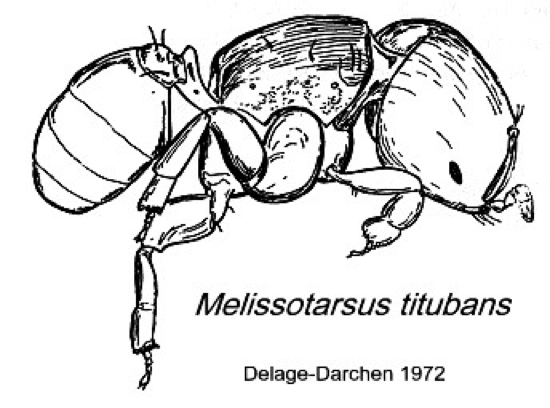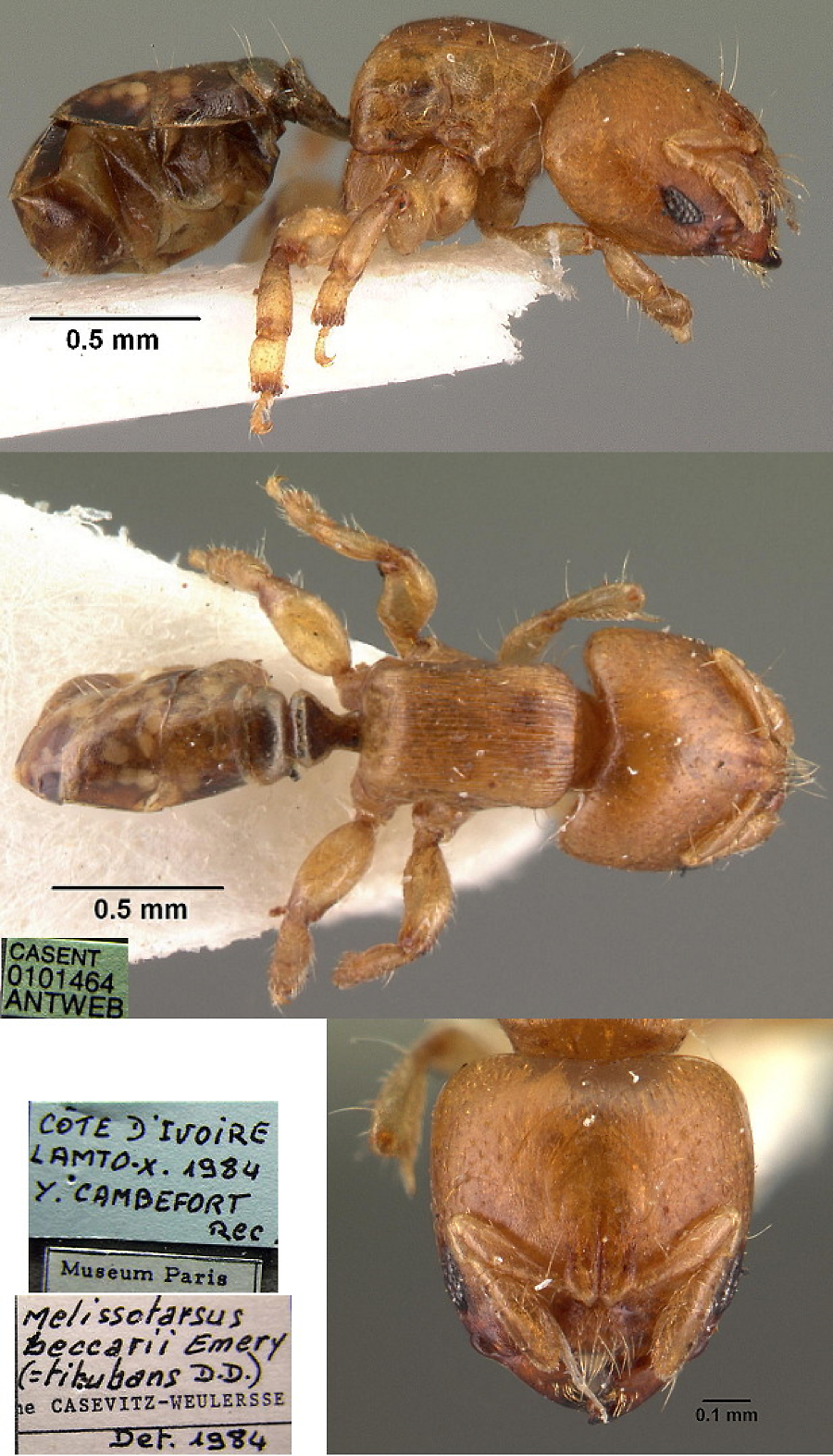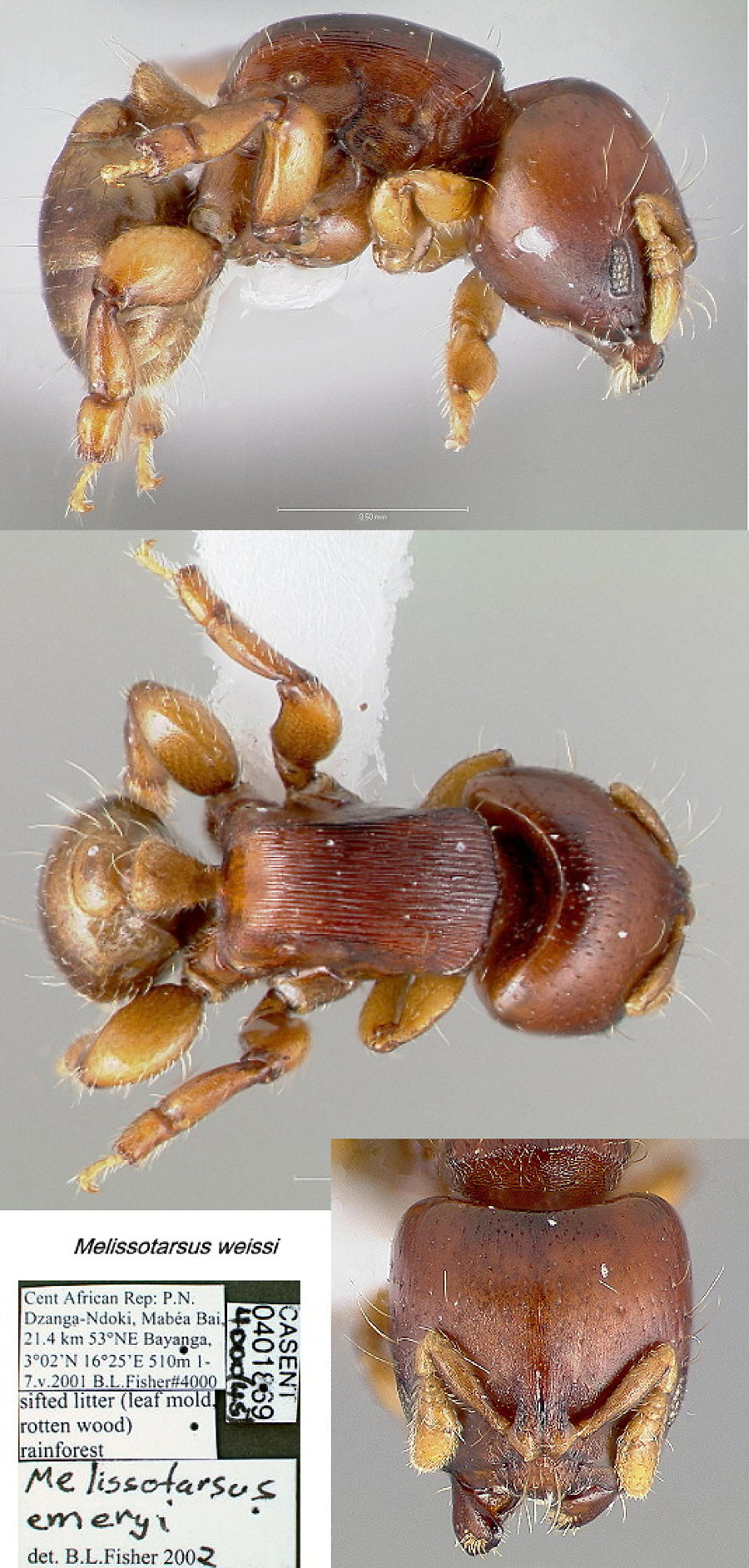Melissotarsus weissi Santschi
  Type location (holotype
female) Congo (Melissotarsus
Weissi, n. sp., Santschi, 1910c: 356, illustrated, queen;
Bolton, 1982: 335, male) collected at Brazzaville by A. Weiss - damaged type see http://www.antweb.org/specimenImages.do?name=casent0913017 Type location (holotype
female) Congo (Melissotarsus
Weissi, n. sp., Santschi, 1910c: 356, illustrated, queen;
Bolton, 1982: 335, male) collected at Brazzaville by A. Weiss - damaged type see http://www.antweb.org/specimenImages.do?name=casent0913017
junior
synonyms
titubans (Delage-Darchen, 1972: 216, illustrated,
all
forms) from Ivory Coast - see https://www.antweb.org/specimenImages.do?code=casent0913762
major (Melissotarsus
major, n. sp., Santschi, 1919h:
85, worker; Santschi, 1923e: 277, queen & male) from Zaïre,
collected at Penghe, by J Bequaert - see http://www.antweb.org/specimenImages.do?code=casent0913018
all forms known (see Bolton, 1982,
1995)  . .
|
 Santschi's (1910c)
description of the queen is at Santschi's (1910c)
description of the queen is at  and Santschi's (1919h) description of major
is at and Santschi's (1919h) description of major
is at  . Santschi's (1923e)
description of the queen and male of major is at . Santschi's (1923e)
description of the queen and male of major is at  . Delage-Darchen's description of titubans
(1972a) is at . Delage-Darchen's description of titubans
(1972a) is at  . Bolton's modern
description (1982) is at . Bolton's modern
description (1982) is at  . .
WORKER - TL 2.3-3.0 mm; similar to beccarii but
darker in colour; anterior margin and lateral margins of alitrunk
dorsum both angled (Bolton, 1982 illustrated, profile and head).
In the wider text, page 335, Bolton had: "I define weissi
as having a dark brown to strongly scletoized male and a similarly
coloured female in which the postpetiole in dorsal view is quite narrow
(1.2-1.40 broader than long) and has a rounded or even hemispherical
anterior margin.
Bolton (1982) reported a finding by himself at CRIG, Ghana
and another at Kamaiembi, Zaïre, by H. Schouteden.
|
 The illustration of titubans
by Delage-Darchen (1972, right), although somewhat of a
sketch, appears to show the sharp angle at the anterior of the pronotum
but gives no impression of there being a well-marked angle between the
sides and dorsum of the alitrunk. She also noted that all specimens
were similarly coloured and sculptured. This is comfirmed by the
photomontage below. The illustration of titubans
by Delage-Darchen (1972, right), although somewhat of a
sketch, appears to show the sharp angle at the anterior of the pronotum
but gives no impression of there being a well-marked angle between the
sides and dorsum of the alitrunk. She also noted that all specimens
were similarly coloured and sculptured. This is comfirmed by the
photomontage below.
As Melissotarsus titubans described from Lamto,
Ivory Coast by Delage-Darchen (1972), who reported its biology.
Nests in narrow tunnels under the bark of forest gallery trees and has
the curious habit of holding its middle legs upwards, apparently
touching the roof of the tunnels. They live in large groups, possibly
being polygynous and tend coccids.
|
 The
photomontage of titubans is collated from http://www.antweb.org/specimen.do?name=casent0101464 The
photomontage of titubans is collated from http://www.antweb.org/specimen.do?name=casent0101464
|
Oxford University Museum
specimens
Melissotarsus weissi
B Taylor det.
Male
|
Central African
Republic
P Annoyer
PU
|
30.xi.2010
Dzanga-Sangha
2°28'49.5"N
16°12'55.9"E
|
392 m; nuit, UV,
Azobé, sol, camp de base lac 1
|
1
|
 |
|
 The photomontage is of
a male from Central African Republic, Dzangha-Sangha NP;
collector P Annoyer (CAR PU) The photomontage is of
a male from Central African Republic, Dzangha-Sangha NP;
collector P Annoyer (CAR PU)
|
 The
photomontage is collated from http://www.antweb.org/specimen.do?name=casent0401869
(note - there it is is labelled as emeryi, but the lateral margins
of the alitrunk are distinctly angled). The
photomontage is collated from http://www.antweb.org/specimen.do?name=casent0401869
(note - there it is is labelled as emeryi, but the lateral margins
of the alitrunk are distinctly angled).
Collection details - Locality: Central African Republic:
Prefecture Sangha-Mbaéré; Parc National Dzanga-Ndoki, Mabéa Bai, 21.4
km 53° NE Bayanga; 03°02'00"N 016°24'36"E, 510m. Collection
Information: Collection codes: BLF4000. Date: 1-7 May 2001. Collected
by: B.L.Fisher. Method: EC19 sifted litter (leaf mould, rotten wood).
Habitat: rainforest. Transect Type: MW 50 sample transect, 5m Transect
Sample No.: 45.
|
|